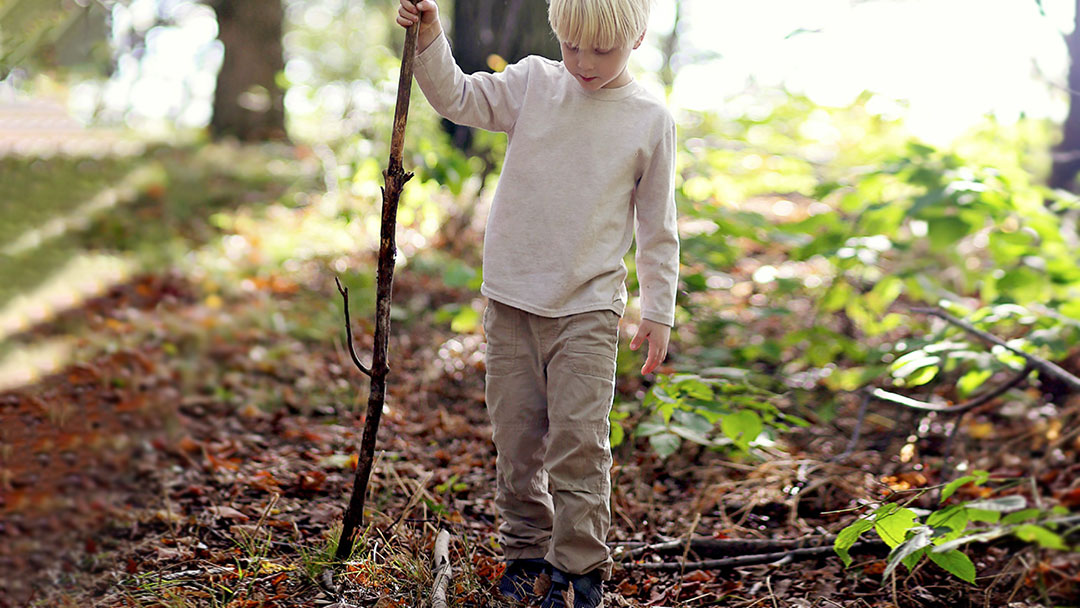by jacob rodenburg
Becoming Part of the Landscape
If you’re like me, a walk through the woods is a loud affair. Stepping on sticks, squelching through mud, shuffling over dried leaves, and smashing through branches—whatever wildlife may have been hiding is long gone. There is an art to walking quietly (i.e., stalking). Our ancestors and Indigenous people all over the world learned to stalk prey by getting as close as possible for a successful hunt.
There are several games you can practice that can help you move through the forest silently and mindfully as though you are a part of the landscape, instead of sounding like an intruder.
Stalking
Place your hands on your knees and crouch just a bit. By taking this position, you can freeze at any moment during your walk if necessary. Begin with the weight of your body on your back leg; take a small step and ease your weight onto the toes of your front foot; make sure there are no crunchy leaves or dried sticks before you commit your entire weight. If clear, transfer all your weight onto those toes, then roll along the outside of your foot and onto your heel. Do the same with the other foot, taking small and deliberate steps. A good stalker will take a long time to silently move 50 metres!
You can practice on a variety of natural surfaces—a grassy field, a forest floor, or a stony path. Once you have the hang of it, try these stalking games:
Group Stalking
This game is for five or more participants. How many can successfully stalk without a sound?
- Have two volunteers crouch on the ground, blindfolded facing each other, about five meters apart
- One at a time, challenge your participants to stalk quietly between the blindfolded volunteers, using the technique above. If the blindfolded volunteers hear a sound, they should point exactly to where the sound is coming from. If they point directly at a participant, that person must sit down
Variation:
- Form a large circle with participants facing inwards approximately 10 to 15 metres wide. Have a volunteer sit in the middle blindfolded and place enough sticks (popsicle sticks will do nicely) near them— one for each person in the circle
- Instruct the participants around the circle to see if they can stalk and grab a stick. The volunteer in the middle points if they hear a sound. If they point directly at the stalker, that person must return to the circle. How many can successfully steal a stick?
Drum Stalking
You’ll need a drum or two sticks that make a loud sound when clacked together. Have a volunteer (prey) hide in the woods nearby. Participants (hunters) try to catch the prey by touching them. The prey must make a thump on their drum or with their sticks every 10 seconds or so; they are free to move about. Hunters use the sound of the drum/sticks to locate their prey and use the art of stalking to find and reach them. If the prey sees someone coming, they point and that person must move five metres away. Will there be a successful hunt?
Deer Walking
If you can, take the time to observe a robin as they move along the ground. Notice how they stop, look around, hop a few steps, quickly peck for food, stare, and then hop again. Many animals use this method to move through the landscape to forage for food and stop and pay attention to their surroundings. When humans walk through their environment, they tend to plod along at a consistent speed. Many predatory animals move in the same way. Foxes, wolves, and coyotes have what is known as a harmonic gate: a purposeful walk that helps them move quickly and efficiently through their hunting territory.
We can learn from animals that need to be wary of their surroundings. A deer’s ears are constantly swivelling, their nose twitching, while their bulging eyes positioned on either side of their head help them take in a wide swath of landscape. Their survival depends on being constantly alert. At the same time, they often stop and stand stock still—this allows them to take in their surroundings while their fur helps them to blend into the forest. In this simple activity, we mimic the movements of a deer so that just like a deer, we can be more aware of the natural world around us:
- Pick a number (let’s say five). Now take five steps and freeze for five seconds. While frozen, try to activate your sense of sight, hearing, and smell
- Pick another number (this time 10). Like before, take 10 steps and freeze for 10 seconds; what do you see, hear and smell?
- Keep up this pattern of selecting a number and taking that number of steps and seconds freezing
- When you compare this type of movement to a regular walk, were you more aware of the natural world around you?
The next time you’re on a nature walk in the forest, try stalking. Who knows what you might see by being part of the landscape!


